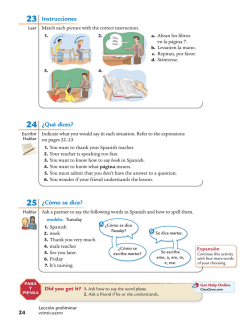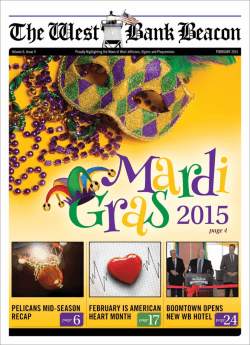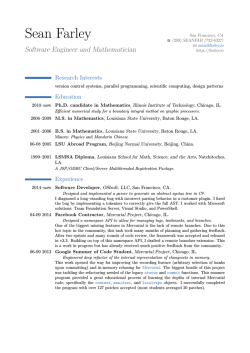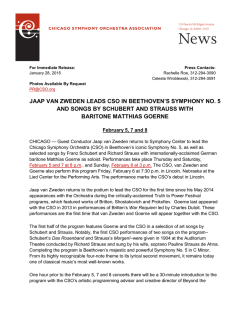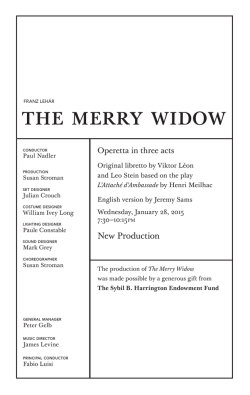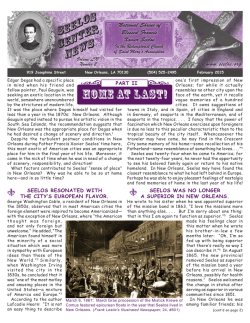
New Orleans and the Spanish World
New Orleans and the Spanish World A concert presented by The Historic New Orleans Collection & the Louisiana Philharmonic Orchestra “New Orleans and the Spanish World” is the ninth installment of Musical Louisiana: America’s Cultural Heritage, an annual series presented by The Historic New Orleans Collection and the Louisiana Philharmonic Orchestra. Dedicated to the study of Louisiana’s contributions to the world of classical music, the award-winning program also provides online educational materials to fourth- and eighth-grade public and private school teachers throughout Louisiana. Copies of the program and the accompanying CD are sent to university music libraries across the state, as well as professors and music programs nationwide. Since the program’s inception, Musical Louisiana has garnered both local and national recognition. The 2008 presentation, “Music of the Mississippi,” won the Big Easy Award for Arts Education; “Made in Louisiana” (2009) received an Access to Artistic Excellence grant from the National Endowment for the Arts; “Identity, History, Legacy: La Société Philharmonique” (2011) received an American Masterpieces: Three Centuries of Artistic Genius grant from the National Endowment for the Arts; and “Envisioning Louisiana” (2013) won a $20,000 grant from the National Endowment for the Arts to support its educational component. The Andrew W. Mellon Foundation made possible the streaming of the 2012, 2013, and 2014 concerts. The 2014 program, “Postcards from Paris,” attracted viewers in ten countries and reached 26,000 listeners through the radio broadcasts on WWNO and KTLN. “New Orleans and the Spanish World” celebrates the rich cultural and musical relations between Spain and Louisiana. To help us celebrate this tradition of musical exchange, Damián del Castillo from Spain and Abdiel Vázquez from Mexico have traveled to New Orleans to serve as soloists. This year’s concert is once again streaming live on LPOmusic.com, supported by the PanAmerican Life Insurance Group, and WWNO will broadcast the program live on 89.9 FM, KTLN 90.5 FM, and wwno.org. Sponsored by Live internet streaming of this concert on LPOmusic.com is supported by Pan-American Life Insurance Group. \ Please silence your cell phones during the performance. The use of recording devices and flash photography is strictly prohibited. COVER IMAGE: Detail from The Tango: see page 10 The Historic New Orleans Collection and The Louisiana Philharmonic Orchestra Carlos Miguel Prieto Adelaide Wisdom Benjamin Music Director and Principal Conductor PR E SE N T New Orleans and the Spanish World Carlos Miguel Prieto, conductor Damián del Castillo, baritone Karol Mossakowski, organ Rafael R. Shabetai, narrator Abdiel Vázquez, piano Wednesday, February 4, 2015 Cathedral-Basilica of St. Louis, King of France New Orleans, Louisiana The Historic New Orleans Collection and the Louisiana Philharmonic Orchestra gratefully acknowledge the Very Rev. Gregory M. Aymond, archbishop of New Orleans; Very Rev. Philip G. Landry, rector of the St. Louis Cathedral; and the staff of the St. Louis Cathedral for their generous support and assistance with this evening’s performance. NEW OR LE A NS A ND THE SPA NISH WOR LD “You can listen in New Orleans to the music of the Spanish nations, which in many cases is inexpressibly beautiful. In Mexico, for example, there has been developed a school which combines, so far as I can see, the tendencies of the Spanish race on the one hand and of the Aztec and Tolteca on the other. This school has expressed itself in hundreds of songs, zarzuelas, danzas, masses, sonatas, and operettas. Not more than a score of these have been heard in New York, but hundreds of them are household words in New Orleans. It would seem as if the love of melody decreases as you come north from the Gulf of Mexico, and reaches its smallest development when it encounters the northern tier of the states of the union.” —William T. Francis in the Daily Picayune, January 2, 1890 In the wake of Christopher Columbus’s voyage to the New World, the Treaty of Tordesillas divided the nonEuropean world between the two Iberian naval superpowers—Spain and Portugal. With a stroke of a pen on June 7, 1494, what would eventually become Louisiana was declared Spanish. The first Europeans known to visit Louisiana were Alonso Álvarez de Pineda, who traversed the Gulf Coast in 1519, and Hernando de Soto, whose party explored the lower Mississippi River valley from 1539 to 1543. The land was largely ignored by Spain for 140 years, and as a result, in 1682 René-Robert Cavelier, sieur de La Salle, claimed the territory for France. Louisiana’s distance from France and its other New World claims made trade and travel difficult. In contrast, the proximity and the extent of Spanish provinces in the Western hemisphere—including Havana, Merida, Veracruz, and Spain’s holdings in Florida—meant that the young French colony was surrounded by Spanish influence, resulting in close ties between Louisiana and the Spanish New World. Once the colony was transferred from France to Spain, in 1762, authorities in Havana and Mexico City oversaw the colony’s operations, further cementing Louisiana’s connections to the wider Spanish New World. This period proved to be formative in the development of the Louisiana settlement. Recognizing the need to Nouvelle Orléans; ca. 1834; print by Ambroise Louis Garneray, painter; Sigismond Himely, engraver; Edouard Hocquart, printer; THNOC, 1974.25.8.248 ABOVE: 2 populate the colony in order to protect it against French and British interests, Spain encouraged the immigration of Canary Islanders, Malagueños—natives of Málaga, Spain—and displaced Acadians. Arts and culture also saw a boom during the decades of Spanish rule. Louisiana’s first newspaper appeared in 1794, and its first opera was performed two years later. (The fact that both the newspaper, Le Moniteur de la Louisiane, and the opera, Sylvain, were French testifies to the colony’s linguistic multivalence.) Individual Spanish artists had long been entwined with European colonization efforts— the Spanish painter Miguel García, for instance, was a member of Jean-Baptiste Le Moyne, sieur de Bienville’s 1699 party—but by the late eighteenth century, New Orleans was large enough to support a small community of artists, including Joseph Furcoty, Joseph Herrera, and José de Salazar. Indeed, the city’s growth may be credited in large part to the Spanish philanthropist Andrés Almonester y Roxas. The construction of the Royal Hospital (1783), the Leper’s Hospital (1785), and the church of the Ursuline nuns (1787) was mere prelude to his buildings that have come to define New Orleans: the Presbytère, the parish church of St. Louis, and the Cabildo. Together with the apartment complex of his daughter, the Baroness Pontalba, these buildings form one of the most wellknown civic centers in the United States. New Orleans’s relationship to the Spanish world did not end with the Louisiana Purchase. The Spanish press in particular continued to grow in importance. No fewer than thirty-seven Spanish newspapers were published in New Orleans during the nineteenth century. Both the French L’Abeille de la Nouvelle-Orléans and the English Times-Democrat had Spanish sections. New Orleans also became important politically as a home for Spanish American political exiles such as Benito Juárez of Mexico, and Venezuelan buccaneer Narciso López used New Orleans as a base of operations for his efforts to free Cuba from Spain. President Porfirio Díaz of Mexico showcased the richness of Mexico at the 1884 World’s Industrial and Cotton Centennial Exposition in New Orleans. In the twentieth century, educational and economic initiatives enhanced the relationship between Louisiana and the Spanish world. As the Panama Canal neared completion, New Orleanians envisioned their city ABOVE LEFT: Header from La Patria; January 1849; newspaper; THNOC. 59-222-L ABOVE RIGHT: Mexican section, main building, at the World’s Industrial and Cotton Centennial Exposition at New Orleans; between 1884 and 1885; photograph by Edward L. Wilson; THNOC, 1982.127.53 3 as a link between the Americas and European markets. The monthly El Mercurio, published in New Orleans from 1911 to 1927, was a richly illustrated journal promoting that vision. The New Orleans Board of Trade encouraged the city’s school board to offer classes in Spanish. In 1914, Tulane University opened the College of Commerce and Business Administration with courses focused on Spanish and Latin American markets; in 1924 Tulane’s Middle American Research Institute sponsored major archaeological excavations in the Yucatán. Continuing a tradition that dated to the eighteenth century, Spanish students continued to travel to New Orleans for grammar, high school, and college education. In the mid-1960s, Loyola University’s Human Relations Institute established the InterAmerican Center to train leaders from Latin America in social reform. Later in the twentieth century, New Orleans became a medical center for Latin American patients and for the training of Latin American physicians, through the efforts of Dr. Alton Ochsner. Such activity continued to strengthen New Orleans’s strong socioeconomic and political ties to the Spanish-speaking world. Throughout the twentieth century, the arts continued to imbue the region with a Spanish flavor. A handful of examples give a sense of the richness of the relationship: in 1927, local audiences had the opportunity to witness performances by the great Guerrero-Mendoza theatrical troupe of Spain; in 1952, Loyola University’s College of Music selected Mexican composer Miguel Bernal Jiménez as its dean; and, in 1917, the Fernández family’s theater opened at 335 Bourbon Street to enrich children’s lives with Spanish music and theater. New Orleans remains, to this day, a cultural, economic, and political link to the Spanish world. Dr. Alfred E. Lemmon* Director, Williams Research Center The Historic New Orleans Collection ABOVE: Mercurio volume XII, number seventy; June 1917; newsprint magazine; THNOC, 82-446-RL * Appreciation is extended to Jack Belsom, archivist of the New Orleans Opera Association; Clifford Webber of London; Peter Collins, professor of music at Missouri State University; and María Luz Gonzalez Peña of the Sociedad General de Autores y Editores of Spain, for generously sharing their knowledge of New Orleans music history. 4 PROGR A M Overture to Sylvain André Ernest Modeste Grétry (1741–1813) “Ah, per sempre, io ti perdei” from I puritani Vincenzo Bellini (1801–1835) Damián del Castillo, baritone Overture to Dichter und Bauer Franz von Suppé (1819–1895) Polonesa: Allegro moderato from Concerto in D Major for Piano and Orchestra Abdiel Vázquez, piano Ricardo Castro (1864–1907) Tiento de Batalla 5° tono Punto Baxo Joan Cabanilles (1644–1712) Karol Mossakowski, organ “El Choclo (Tango Criollo)” Ángel Villoldo (1861–1919) “Como tengo la cara nega y no jablo como un señó” Francisco Asenjo Barbieri (1823–1904) from Entre mi mujer y el negro Damián del Castillo, baritone Prelude to El bateo “Roman Carnival” Overture, op. 9 Federico Chueca (1846–1908) Louis-Hector Berlioz (1803–1869) Please silence your cell phones during the performance. The use of recording devices and flash photography is strictly prohibited. 5 PROGR A M NOT E S ANDRÉ ERNEST MODESTE GRÉTRY (1741–1813) Overture to Sylvain Spain’s strong operatic tradition has produced luminaries such as Montserrat Caballé, Victoria de los Ángeles, José Carreras, and Plácido Domingo, and it has inspired the settings of such well-known works as Verdi’s Don Carlo, Ernani, La forza del destino, and Il trovatore, as well as Bizet’s Carmen and Mozart’s Don Giovanni. Beyond people and places, though, Spain’s role in the world of opera has a developmental importance unknown to many casual listeners. Early Spanish opera was distinguished by the high quality of its libretti. The great Spanish playwright Félix Arturo Lope de Vega (1562–1635) wrote the libretto for La selva sin amor for composer Filippo Piccinini (1566–ca. 1638) in 1627. The plays La púrpura de la rosa and Celos aun del aire matan, both written in 1660 by Calderón de la Barca, were transformed into operas by Juan Hidalgo de Polanco (ca. 1614–1685). In the eighteenth century, Spain’s penchant for opera reached across the Atlantic. Mexico presented La Parténope by Silvio Stampiglia (1664–1725) in 1711. Further south, the Teatro de Óperas y Comedias opened in 1757 in Buenos Aires, and in 1776 the Teatro Principal of Havana opened with Dido abandonada by Leonardo Vinci (1680– 1730). The first opera composed in the New World was La púrpura de la rosa by Spaniard Tomás de Torrejón y Velasco (1644–1723). Employing playwright Calderón de la Barca’s text, it premiered in Lima in 1701. Given this strong tradition of Spanish opera, it should be no surprise that the first documented staging of an opera in New Orleans, Sylvain (the modern spelling of the opera), by André Ernest Modeste Grétry (1741–1813), occurred under Spanish rule, on May 22, 1796. While the circumstances concerning the selection of this particular work are unknown, Grétry was no foreigner to Spain or to the Spanish New World. In 1791, his music enjoyed enormous popularity in Havana. Furthermore, Grétry himself selected Spain as the setting for two of his operas, L’amant jaloux (1778) and L’ inquisition de Madrid (1793–1794). ABOVE TOP: Silvain: Comédie en un acte et en vers; ca. 1770; André Ernest Modeste Grétry, composer; THNOC, 2007.0313 ABOVE BOTTOM: 6 Page from Silvain: Comédie en un acte et en vers; ca. 1770; André Ernest Modeste Grétry, composer; THNOC, 2007.0313 VINCENZO BELLINI (1801–1835) “Ah, per sempre, io ti perdei” from I puritani Damián del Castillo, baritone An examination of performances at James Caldwell’s St. Charles Theatre demonstrates the importance of the Havana stage to New Orleans’s arts scene. A succession of Italian travelling opera companies from Havana presented numerous US premieres of Italian operas at the theater. Vincenzo Bellini’s I puritani, though not premiered at the St. Charles due to the 1842 fire, joined a lengthy list of Italian operas being performed in the city. Its first US performance occurred at the New American Theater on Poydras Street, while the St. Charles was closed. Set during England’s civil war of the 1640s, the opera, which received its Havana premiere in 1843, opens to find the Puritan stronghold of Plymouth under attack by the Royalists. Elvira, the daughter of the fort’s commander, is betrothed to Riccardo, but her heart belongs to Arturo, a Royalist. Upon learning of this, Riccardo laments the loss of Elvira, his “flower of love,” in the aria “Ah, per sempre.” FRANZ VON SUPPÉ (1819–1895) Overture to Dichter und Bauer The 1884 World’s Industrial and Cotton Centennial Exposition, held in New Orleans at the current site of Audubon Park, was a tremendous musical celebration. The rich and varied musical program featured local musicians, such as organist Henry Pilcher, alongside visiting national and international groups. Mexican musicians were particularly prominent, including the Eighth Cavalry Band, under the direction of Encarnación Payen, and the Typical Mexican Orchestra, under the direction of Carlos Curti. While both ensembles understood New Orleanians’ love of opera and shaped their repertoires accordingly, other performers, such as a troupe of Mayan ABOVE : Interior of the St. Charles Theater; original etching created between 1835 and 1885; copy photograph created between 1930 and 1939; photograph by Charles L. Franck Photographers; Charles L. Franck Studio Collection at The Historic New Orleans Collection, 1979.89.7485 7 Indian dancers and a marimba band from Guatemala, highlighted the more “exotic” musical traditions of Mexico and Central America. Public response to the Mexican performing groups was overwhelming. They attracted audiences to various venues across the city—the Exposition, the French Opera House, St. Louis Cathedral, the Carrollton Gardens, and Upper Bethel Church on Jackson Avenue. Central to their success was their performance of opera music. Transcriptions of overtures for brass bands and selections from operas by composers such as Auber, Donizetti, Meyerbeer, and Rossini were the normal fare, but Mexican music was not overlooked. The Mexican music proved to be so popular that local music entrepreneur Junius Hart busied himself publishing sixty-three piano transcriptions of such works as El Nopal, A media noche, and Chloé. Eventually, his advertisements for these transcriptions claimed, “Over 100,000 copies already sold.” The works of Austrian composer and conductor Franz von Suppé were especially popular pieces in the repertoires of the Eighth Cavalry Band and the Typical Mexican Orchestra. Written in 1846 when von Suppé was only twenty-seven, Dichter und Bauer (The Poet and the Peasant) is one of his earlier works. Like the Light Cavalry Overture and Morning, Noon, and Night in Vienna, it has become standard repertoire for “pops” concerts. All three have been immortalized in animated cartoons: Morning, Noon, and Night was used in the Bugs Bunny cartoon “Baton Bunny,” the Light Cavalry in the Mickey Mouse short Symphony Hour, and “The Poet and the Peasant” overture in the Popeye the Sailor episode “The Spinach Overture.” RICARDO CASTRO (1864–1907) Polonesa: Allegro moderato from Concerto in D Major for Piano and Orchestra Abdiel Vázquez, piano On March 8, 1885, the Eighth Cavalry Band performed with Ricardo Castro, a young Mexican pianist. Only twenty-one years old, he was an established recitalist who had represented Mexico in Caracas for centenary celebrations honoring the birth of Simon Bolívar, the Venezuelan political and military leader. Castro’s New Orleans appearance was part of a larger tour that took him to Chicago, Philadelphia, Washington, DC, and New York. ABOVE LEFT: Brass band of E. Payen; between 1884 and 1885; photograph by Edward L. Wilson; THNOC, 1982.127.225 ABOVE RIGHT: 8 Mexican Music; 1889; Junius Hart, publisher; THNOC, 86-1724-RL Recognizing the lack of a chamber music tradition in Mexico, Castro organized the Sociedad Filarmónica Mexicana while continuing to pursue his career as a composer. In 1902, he was awarded a government grant for additional studies in France, and his abilities as a pianist were touted in Le Figaro and Le Monde Musical. His Concerto in D Major for Piano and Orchestra premiered in Antwerp on December 28, 1904, with Castro as soloist. The January 1, 1905, issue of La Fédération Artistique noted that “the composer gave a masterful performance of his Concerto for Piano” and described it as a “dashing and effective work.” Musicologist Robert Stevenson has observed that the concerto demonstrates that “Castro had mastered the conventional pianism of his epoch.” Completing his second opera, La légende de Rudel, Castro secured a contract with the Leipzig publisher Friedrich Hofmeister for his larger works. Returning to Mexico in triumph in 1906, he was named director of the National Conservatory. In November 1907 he succumbed to pneumonia at the age of 43. JOAN CABANILLES (1644–1712) Tiento de Batalla 5º tono Punto Baxo Bernardo de Gálvez (1746–1786) is usually remembered as the Spanish governor of Louisiana who aided the American Revolution by ensuring that arms, supplies, and money reached George Washington via the Mississippi River. His defeats of British forces at Manchac, Baton Rouge, Natchez, Mobile, and Pensacola were critical to the war effort. Yet his interests extended far beyond his military responsibilities. During his years studying military science in France, he also devoted himself to the study of French language and culture. In Louisiana and Mexico, he became a tireless promoter of the performing arts. As governor, he hired Vicente Llorca (ca. 1750–1803), a veteran of the 1781 Pensacola campaign and a professionally trained musician, to be chapel master at the parish church of St. Louis in New Orleans (the presentday cathedral). Gálvez instructed Llorca to compose “music in the Spanish style.” This category would have included such musical forms as batallas and tientos. A type of vocal work dating to the fifteenth century, batallas were designed to represent and express various aspects of a battle. By the late seventeenth and early eighteenth centuries the form had become more complex and more closely associated with the organ, which was used to approximate the sound of battle trumpets. In Spain, batallas were traditionally performed in commemoration of great battles with “enemies of the faith.” The tiento, another popular musical form during Llorca’s day, derives its name from UPPER RIGHT: LOWER LEFT: Image of Ricardo Castro from Revista Musical de Mexico; November 15, 1919; newsprint magazine; private collection Don Bernardo de Gálvez; between 1780 and 1786; representational portrait; THNOC, 2000.80.1 9 the Spanish verb tentar, meaning “to touch,” and can be described as an imitative fantasy. Joan Cabanilles (like Llorca, a native of Valencia, Spain) composed works for organ and for choirs. His choral works were composed for liturgical use and are characterized by their advanced harmony and use of counterpoint. ÁNGEL VILLOLDO (1861–1919) “El Choclo (Tango Criollo)” Created in the slums of Buenos Aires by homesick and poor European immigrants and displaced gauchos in the late nineteenth century, the tango is a mixture of European, African, and New World musical traditions. Originally considered obscene due to its sexually suggestive nature, it was brought to Paris around 1913 by wealthy Argentine expatriates and quickly spread through Europe and to the United States. Illustrated guides to the tango, such as Samuel Beach Chester’s Secrets of the Tango: Its History and How to Dance It (1914), soon appeared. Vernon and Irene Castle’s Modern Dancing (1914) distinguished between the Argentine tango (“the most difficult of the new dances”) and the “Tango Brésilienne or Maxixe,” while exhorting dancers to perform a graceful, “sublimated form of the tango.” New Orleans soon succumbed to the tango, and newspapers reported on the formation of a club known as Tangoitis, which was devoted to the tango. The area surrounded by Iberville, Bienville, and North Rampart streets became known as the Tango Belt, because of the concentration of dance halls. While New Orleanians quickly accepted the dance, local critics joined an international array of opponents (ranging from the cardinal of Paris to the pope) in denouncing it. Police superintendent James W. Reynolds declared that light had to be visible between the two dancers. Across the country women wore special “bumpers” on their dresses to prevent them from coming into contact with their partners’ bodies. Premiered in 1903, Villoldo’s “El Choclo” is one of the most popular Argentine tangos. The title (meaning “the corn cob”) is taken from the nickname of a beloved Buenos Aires nightclub proprietor. UPPER RIGHT: LOWER LEFT: 10 The Tango; ca. 1947; watercolor on paper float design by Alice Peak Reiss, designer; THNOC, gift of School of Design, 1996.67.12 Le vrai tango argentin; 1911; sheet music by Ángel Villoldo, composer; THNOC, 2014.0316 FRANCISCO ASENJO BARBIERI (1823–1904) “Como tengo la cara nega y no jablo como un señó” from Entre mi mujer y el negro Damián del Castillo, baritone As a composer, scholar, bibliographer, music critic, writer, and impresario, Francisco Asenjo Barbieri made countless and varied contributions to Spanish cultural life. His early interest was in Italian opera, but he soon realized that the Spanish public did not share his enthusiasm and turned instead to the zarzuela—a “theatrical genre characterized by a mixture of singing and spoken dialogue,” according to the Harvard Dictionary of Music—in an effort to create a distinctively Spanish musical theater. Barbieri established societies to promote Spanish music as well as orchestral music, and he rescued long-forgotten Spanish composers from oblivion by delving into the musical archives of the Cathedral of Toledo, the Royal Monastery of San Lorenzo de El Escorial, and the Royal Palace of Madrid. His 1890 publication of El Cancionero de Palacio, a massive collection of fifteenth- and sixteenth-century Spanish songs, remains a milestone in the development of Spanish musicology. His zarzuela Entre mi mujer y el negro had its premiere at Madrid’s Teatro de la Zarzuela on October 14, 1859, to laughter and almost nonstop applause. Several of the numbers were so well received that the audience demanded they be repeated. While many of Barbieri’s zarzuelas were set in Madrid, this one was set in a luxurious New Orleans hotel. The opening scene sings the praises of the local coffee and celebrates the abundance of Jamaican rum. Roast beef and fish are proclaimed to be “without equal.” Benjamin, a slave, sings “Como tengo la cara nega y no jablo como un señó,” expressing his love for his wife Pancha while lamenting that his face is black and that he does not speak like a “señor.” After its success, Barbieri dreamed of a Paris production, and he had a French version prepared. Disputes with the theater manager and the translator over royalties prevented its staging, and it remains the only work of Barbieri’s to be translated into French. FEDERICO CHUECA (1846–1908) Prelude to El bateo The zarzuela tradition dates to the 1650s, when the Palacio Real de la Zarzuela—a royal hunting lodge outside of Madrid where shrubs known as zarzas, or brambles, abound—regularly hosted the forerunners of these distinctive musical plays. The tradition took root and thrived across the Spanish-speaking world, and British musicologist Christopher Webber has noted that “zarzuela means to Spain what operetta means to Vienna, Offenbach to Paris, Gilbert and Sullivan to London, and the musical to Broadway.” Beginning his studies at the Madrid Conservatory, Federico Chueca eventually decided to pursue medicine. The death of his parents resulted in his forgoing a medical career and returning to the conservatory. Within a matter of years, he was a conductor at Madrid’s Teatro de Variedades. He subsequently collaborated with librettist Joaquín Valverde to produce several successful zarzuelas. El bateo (the baptism) premiered at Madrid’s Teatro de la Zarzuela in 1901 and is the last of Chueca’s ABOVE RIGHT: Title page of Entre mi mujer y el negro; 1871; written by Luis Olona, author; THNOC, 2011.0353 11 great successes. Written in one act, it opens with the baptism of a child whose mother is suspected of infidelity. In the end, the mother’s virtue is confirmed and the baby’s true father revealed. A musical tour-de-force, El bateo features comical choral interludes—at one point, singers bemoan the fact that Madrid audiences will soon be stuck listening to music by the likes of Beethoven and Mozart—and quotes musical themes from other popular zarzuelas. Chueca wittily plays with cultural stereotypes: as a “French” photographer busily arranges the family portrait, a group of musicians awkwardly attempts to perform a French minuet. The prelude is a rhythmic wonder, incorporating many of the then-popular dance rhythms. LOUIS-HECTOR BERLIOZ (1803–1869) “Roman Carnival” Overture, op. 9 On November 1, 1955, at the opening concert of the twentieth season of the New Orleans Philharmonic Symphony Orchestra, Gen. L. Kemper Williams, then president of the organization, announced that the US Department of State had selected the New Orleans orchestra to make a four-week tour of Latin America. Under the auspices of the American National Theater and Academy, an agency established as part of President Dwight D. Eisenhower’s emergency fund for cultural affairs, the New York Philharmonic and Philadelphia Orchestra had visited Europe, and the one-time NBC Symphony Orchestra toured the Far East. However, this was the agency’s first effort to send an orchestra to Latin America. The selection of the New Orleans orchestra underscored the city’s role as the “Gateway to the Americas.” On Monday afternoon, April 2, 1956, the eighty-eight-member orchestra boarded two planes, the Allegro and the Scherzo, each emblazoned with the symphony’s name. As the musicians boarded the aircraft they were serenaded by a jazz ensemble playing “Alexander’s Ragtime Band” in honor of conductor Alexander Hilsberg. On May 6, the Times-Picayune noted that the symphony scored a “very popular success concertizing in…seventeen Latin American countries.” Reviewers from Caracas to Mexico City showered praise upon the orchestra, garnering the attention of New York Times music critic Harold Taubman, who joined in the praise of the musicians. Gen. Williams and his wife, Leila, who would eventually found The Historic New Orleans Collection, joined the orchestra on its tour. His diary provides information regarding the music performed on the tour. One of the works was Hector Berlioz’s “Roman Carnival” Overture. Based on musical themes from the composer’s opera Benvenuto Cellini, the work has remained enormously popular since its 1844 premiere. Berlioz routinely included it on the programs of his concert tours. The fact that the New Orleans musicians carried it to distant lands would have been particularly pleasing to Berlioz: in his memoir he recalled that as a child he had “a thirst for knowing distant countries” and would spend “long hours in front of atlases” and “brood over the creation of those distant lands.” ABOVE: Mayor deLesseps Morrison presents Alexander Hilsberg, Mrs. F. Evans Farwell, and Gen. L. Kemper Williams with the International Order of Merit; May 2, 1958; THNOC, gift of Marilyn Barnett, 84-28-L.2 12 PE R FOR M E R BIOGR A PH I E S Widely celebrated as a rising star in the United States, Canada, and his native Mexico, Carlos Miguel Prieto’s charismatic conducting, characterized by its dynamism and the expressivity of his interpretations, has led to major engagements and popular acclaim throughout North America and Europe. In great demand as a guest conductor with many of the top North American orchestras, his relationships with orchestras in Europe, Latin America, and the United Kingdom continue to expand. Recognized as the leading Mexican conductor of his generation, Prieto holds four music directorships: with the Louisiana Philharmonic Orchestra, the Orquesta Sinfónica Nacional de Mexico, the Orquesta Sinfónica de Mineria, and the YOA Orchestra of the Americas. Guest engagements of note during 2014– 15 include debuts with New Zealand’s Auckland Philharmonia Orchestra, Scotland’s BBC Scottish Symphony, and Great Britain’s Royal Liverpool Philharmonic Orchestra. He also led the United Kingdom premiere of Giovanni Sollima’s Antidotum Tarantulae XXI, Concerto for Two Cellos, with the Liverpool Philharmonic. Additionally, Prieto guests with the NDR Sinfonieorchester (the North German Radio Symphony Orchestra), the Calgary Philharmonic Orchestra, and the Chicago Symphony Orchestra. Recent engagements include Germany’s NDR Radiophilharmonie at the Rheingau Musik Festival, the Mainly Mozart Festival in San Diego, and the Colorado Music Festival. Renowned for championing Latin American music, Prieto has conducted over fifty world premieres of works by Mexican and American composers, many of which were commissioned by him. Prieto has an extensive discography that covers labels including Naxos and Sony. His most recent recording is a highly acclaimed CD for Naxos featuring Carlos Chávez’s Piano Concerto with pianist Jorge Federico Osorio and the Orquesta Sinfónica Nacional de Mexico. DAMIÁN DEL CASTILLO, BARITONE Damián del Castillo was born in Úbeda in the Jaén province of Andalusia. He graduated with a degree in music with a concentration in voice from the Conservatory of Málaga, studying with Alicia Molina. He attended the Escuela Superior de Música Reina Sofía in Madrid, working with such teachers as Manuel Cid and Tom Krause. He took master classes with Teresa Berganza, Reri Grist, and Giancarlo del Monaco. Currently he is studying under Carlos Chausson. He has sung as soloist at Madrid’s Teatro Real, Auditorio Nacional de Música, and Teatro de la Zarzuela; Milan’s Teatro La Scala, Barcelona’s Gran Teatre del Liceu, Bilbao’s Palacio Euskalduna Juaregia, Teatro Cervantes in Málaga, Teatro Villamarta in Jerez, Santander’s Palacio de Festivales, Córdoba’s Mosque-Cathedral, and Museo Nacional del Prado. In 2011, del Castillo was a winner at the Seville voice competition “Nuevas voces.” He was also a finalist at the ninth Acisclo Fernández Carriedo, an international vocal competition, and at the third Villa de Colmenar Viejo. He has sung at the First International Festival of Latin American and Spanish Music in Kansas City, the Festival of Music and Dance in Úbeda, the Festival de Otoño in Jaén, Málaga’s Antique Music Festival, and the Portuguese Festival Terras Sem Sombra. Del Castillo recently received a grant from the Asociación de Artistas Interpretes o Ejecutantes Sociedad de Gestión de España (AIE). © Benjamin Ealovega, 2000 CARLOS MIGUEL PRIETO, CONDUCTOR KAROL MOSSAKOWSKI, ORGAN Born in Poland in 1990 into a family of musicians, Karol Mossakowski started studying the piano and the organ with his father at the age of three. After high school, he entered the Pozna Music Academy, where he studied organ with Elzbieta Karolak and Jarosław Tarnawski. In 2011 he entered the Conservatoire National Supérieur de Musique et de Danse de Paris 13 as a pupil of Olivier Latry and Michel Bouvard. Since 2013, he has also been pursuing studies in improvisation with Thierry Escaich and Philippe Lefebvre and harmony with Fabien Waksman. In Poland Mossakowski won several national competitions, such as the 2010 Feliks Nowowiejski International Competition in Poznan. In May 2013 he won first prize at the famous Springtime International Competition in Prague. That success allowed him to participate in other festivals and with orchestras around the world, including events in the Czech Republic, Poland, Slovakia, and England. The recipient of a scholarship from the French government, Mossakowski has also received a grant from the Brieux-Ustaritz Foundation. In November 2014 he was named youngartist-in-residence at the Cathedral-Basilica of St. Louis, King of France, in New Orleans. RAFAEL R. SHABETAI, NARRATOR Born in Buenos Aires, Argentina, Rafael R. Shabetai is vice president and chief underwriting officer of Pan-American Life Insurance Group, joining the company in July 2001. Shabetai is a recognized speaker in the life underwriting industry—he gave lectures at the International Underwriting Congress in 1999 and 2005 and at several Association of Home Office Underwriter conferences. He holds a bachelor of arts degree from the School of Law at the University of Buenos Aires, and he is accredited by the American Translators Association. He is also a graduate of the Institute of Social Communications of Buenos Aires with an associate’s degree in radio and TV newscasting and broadcast journalism. Prior to coming to the United States, Shabetai was a journalist and broadcaster with the Argentine National Public Radio (LRA Radio Nacional) and the Public Broadcasting of the City of Buenos Aires (LS1 Radio de la Ciudad de Buenos Aires). Shabetai and his wife Claudia are producers and hosts of the Spanish cultural and information radio show Suplemento, which airs weekly on KGLA 105.7 FM and 1540 AM radio. He is also a correspondent for CNN En Español Radio, covering news and events in the New Orleans area such as Hurricane Katrina, Hurricane Gustave, the Deepwater Horizon oil spill, and Hurricane Isaac. In 2004 he received the award “Inspiración” from the Hispanic Chamber of Commerce of Louisiana and 14 in 2005, the show was awarded the Broadcast of the Year award by N.O.sotros Magazine. Shabetai lives in Kenner, Louisiana, with his wife Claudia and their labrador retriever “Godiva.” ABDIEL VÁZQUEZ, PIANO Abdiel Vázquez is the winner of the most important piano competitions in Mexico, and in 2013 he was awarded first prize in two competitions open to instrumentalists and singers from all over the world: The World Competition and New York’s Shining Stars Debut Series. The latter represented his debut in Carnegie Hall, performing the New York premiere of Manuel Ponce’s Piano Concerto. Vázquez made his debut, at the age of twenty-one, with the National Symphony Orchestra of Mexico in Bellas Artes Palace performing Sergei Rachmaninoff ’s Piano Concerto No. 3 and since has appeared regularly with all of Mexico’s major orchestras. His engagements in festivals, concerts, competitions, and opera companies have taken him to Asia, Europe, South America, and the United States, in a career that has seen him expand from a concert pianist to an orchestral and operatic conductor. Vázquez was born in Monterrey in 1984, and by the time he finished his conservatory studies in his hometown in 2006 he had already received the National Youth Award from the president of Mexico, the Civic Merit Medal, and the State Youth Award. He then continued his education in New York and Madrid. His mentors include the pianists Gerardo González, James Tocco, and Oxana Yablonskaya; the conductor David Gilbert; and the mezzo-soprano Mignon Dunn. He currently resides in New York City, where he belongs to the faculty of vocal coaches at Manhattan School of Music, and he regularly works with singers and voice teachers from the Metropolitan Opera House and The Juilliard School. LOU ISI A NA PH I L H A R MON IC ORCH E S T R A Carlos Miguel Prieto, Music Director Adelaide Wisdom Benjamin Music Director and Principal Conductor Violins Benjamin Thacher, Concertmaster Edward D. and Louise L. Levy Concertmaster Chair Benjamin Hart, Associate Concertmaster Hannah Yim, Assistant Concertmaster Byron Tauchi, Principal 2nd Violin Xiao Fu, Assistant Principal 2nd Violin Burton Callahan Razvan Constantin Zorica Dimova Judith Armistead Fitzpatrick Eva Liebhaber Zhaneta Mavrova-Yordanov Elizabeth Overweg Gabriel Platica Qi Cao Yaroslav Rudnytsky Karen Sanno Yuki Tanaka Kate Withrow Sarah Yen Violas Richard Woehrle, Principal Abby Ray Catledge and Bryne Lucas Ray Principal Viola Chair Bruce Owen, Assistant Principal Matthew Carrington* Amelia Clingman Valborg Gross Lauren Magnus Ila Rondeau Carole Shand Cellos Jonathan Gerhardt, Principal The Edward B. Benjamin Principal Cello Chair Daniel Lelchuk, Assistant Principal Rachel Hsieh Jeanne Jaubert Kent Jensen David Rosen Dimitri Vychko Basses David Anderson, Principal William Schettler, Assistant Principal Matthew Abramo Paul Macres Benjamin Wheeler Horns Mollie Pate, Principal Matthew Eckenhoff Joshua Paulus Amy Krueger Flutes Heather Zinninger Yarmel, Principal Mary Freeman Wisdom Principal Flute Chair Sarah Schettler Patti Adams, Assistant Principal Richard C. and Nancy Link Adkerson Flute Chair Trumpets Vance Woolf, Principal Stephen Orejudos Doug Reneau, Associate Principal Piccolo Patti Adams Oboes Jaren Atherholt, Principal Jane Gabka, Assistant Principal Michael McGowan English Horn Michael McGowan Clarinets Christopher Pell, Principal Stephanie Thompson, Assistant Principal John Reeks E-Flat Clarinet Stephanie Thompson Bass Clarinet John Reeks Trombones Greg Miller, Principal Matthew Wright Bass Trombone Evan Conroy Tuba Robert Nunez, Principal Timpani Jim Atwood, Principal Percussion Nena Lorenz, Principal* Dave Salay, Acting Principal Guy Gauthreaux Harp Rachel Van Voorhees Kirschman, Principal Piano Mary Ann Bulla Bassoons Andrew Brady, Principal Michael Matushek Benjamin Atherholt, Assistant Principal Contrabassoon Benjamin Atherholt * On leave for the 2014-15 season 15 FOR FURTHER READING Baron, John H. Concert Life in Nineteenth-Century New Orleans. Baton Rouge: Louisiana State University Press, 2013. Kmen, Henry. Music in New Orleans: The Formative Years, 1791–1841. Baton Rouge: Louisiana State University Press, 1966. Madrid, Alejandro L. and Robin D. Moore. Danzón: Circum-Caribbean Dialogues in Music and Dance. Currents in Latin American and Iberian Music, edited by Walter Clark. New York: Oxford University Press, 2013. Preston, Katherine K. Opera on the Road: Traveling Opera Troupes in the United States, 1825–60. Music in American Life. Chicago: University of Illinois Press, 2001. Stewart, Jack. “The Mexican Band Legend: Myth, Reality, and Musical Impact; A Preliminary Investigation.” The Jazz Archivist 6, no. 2 (December 1991): 1–15. ——.“The Mexican Band Legend: Part II.” The Jazz Archivist 9, no. 1 (May 1994): 1–17. ——.“The Mexican Band Legend: Part III.” The Jazz Archivist 20 (2007): 1–23. Webber, Christopher. The Zarzuela Companion. Lanham, MD: The Scarecrow Press, 2002. 16 The Historic New Orleans Collection is a museum, research center, and publisher dedicated to the study and preservation of the history and culture of New Orleans, Louisiana, and the Gulf South. The Collection’s exhibitions, holdings, and publications survey more than three centuries of the region’s economic, social, cultural, and military history. The Collection’s main galleries are located at 533 Royal Street, with research facilities open to the public at the Williams Research Center, 410 Chartres Street, and the Laura Simon Nelson Galleries for Louisiana Art at 400 Chartres Street. Visit www.hnoc.org or call (504) 523-4662 for more details about exhibitions, upcoming programs, and gallery hours. The Louisiana Philharmonic Orchestra’s mission is to transform people and communities through music. As the only full-time professional orchestra in Louisiana, our goals are to perform ambitious, inspiring concerts; educate people of all ages about and through music; engage with diverse audiences; connect to communities through a vast range of mediums and venues; and contribute to the cultural richness of the Gulf South. Now entering our twenty-fourth year, the LPO offers a thirty-six-week season with more than ninety orchestral performances, including classics, light classics, pops, education, family, chamber, park, and community concerts across a multiparish area in south Louisiana. In addition, the LPO provides an orchestral foundation for other cultural and performing arts organizations, including New Orleans Opera Association, New Orleans Vocal Arts Chorale, and Delta Festival Ballet.
© Copyright 2025


